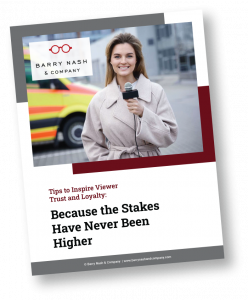The appearance of Sergio Dipp as a sideline reporter on Monday Night Football has received a lot of coverage. Most of it has been harsh. The question that it raised for me is how much of his struggle had to do with nerves? In our work, we constantly encounter introverts who have an inexplicable urge to put themselves in front of millions of people on a daily basis. It is brutal. It is a struggle. It is exhausting. Sometimes the nerves can be crippling.

Even seasoned pros struggle with nerves in a new situation. Or if not nerves, there may be an adrenaline rush that impacts delivery. How do they deal with it?
What are the outward signs that someone is nervous? In general, we see shaking, trembling, shortness of breath, running out of breath, a quivering voice, a voice that breaks, a dry mouth, a monotone delivery, a fast rate of speech, body language that is small and tight, repetitive gestures, and the list goes on. What is happening? The feeling of nervousness – or even just excitement and the rush of adrenaline that mimics nervousness – results in a “fight or flight” response in the body. We tense up. We start to breathe in a high, shallow manner. Our shoulders creep up towards our ears and our heads shift forward. The jaw tightens. This response is helpful if we are in the jungle getting ready to run away from a wild animal, but in a public speaking arena, it can be catastrophic.
So what can you do about it? Here are a few strategies to help you get a handle on the nervous energy so that you can focus on the job at hand.
Breathe: Spend time focusing on your breathing. You want to feel you stomach expand as you inhale and collapse as you exhale. Try to keep the chest and shoulders relatively still. Don’t take a huge breath, just take as much as you need. Try breathing in for five seconds and then breathing out for 5 seconds. Breathe in through your nose and out through puckered lips to help you feel the breath as it leaves the body.
Release tension: Try tightening up all of your muscles, all of them, and holding that tension for 5 seconds. Then let it go. Try rolling your shoulders back. Try shaking out your hands and arms.
Power pose: If you haven’t seen Amy Cuddy’s TED talk or read her book Presence, do yourself a favor and check it out. She discusses power poses that, when held for 2 minutes, raise your testosterone levels which makes you feel more powerful and lower you cortisol levels which helps relieve stress. You will be amazed at how much more confident you feel when you use her poses.
Prepare: Preparation and practice are crucial. And when you practice, actually practice out loud – not just in your head. Your body will remember the practice and take over for you in times of stress. Visualization is a wonderful tool and can be used in conjunction with practice, but actual physical and vocal practice will do so much for you.
Focus on your story and your audience: Instead of thinking about how you are doing, keep in mind your audience. Who are you telling the story to? Why is your story important? Get the focus off of you and onto your audience.
Of course, so much of the impact of nerves weakens with repetition, but until that time comes, try these suggestions so that you begin to have a routine, a ritual that you can rely on.










